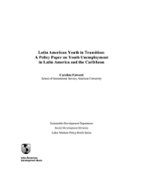Latin American Youth in Transition: A Policy Paper on Youth Unemployment in Latin America and the Caribbean
Date
Jul 2002
This policy analysis looks at the economic relationships between sectors, where formal and informal sectors are intimately linked in terms of youth and adult workers, where skilled workers and their shortages exist throughout all sectors of the economy, and where downsizing and technical change shed large numbers of unskilled labor to the informal sector. Youth unemployment in Latin American and the Caribbean lives in the shadows of the broader labor market demand and wage dynamics, whereby youth unemployment is simply a fractured reflection of larger labor market issues. Moreover, the impact of labor market policies and programs for youth is largely tied to broader labor market dynamics. This policy paper captures these youth dynamics, and their impact on the determinants and policies of youth unemployment. The school-to-work transition is the main point of departure and provides the context to understand the youth unemployment. Youth unemployment is not a transitory state to employment, rather it is a very lengthy process where youth move from unemployment, schooling, unpaid unemployment, and low-wage unskilled employment - all of which have low opportunity costs. Adding another dimension to this process, is that Latin American youth are often simultaneously in school and in work. The highly complex and multi-faceted transition process results in constant change for youth in Latin America.



